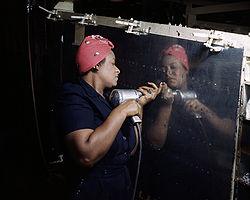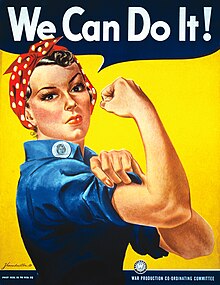| Revision as of 14:03, 12 April 2009 editDebresser (talk | contribs)Autopatrolled, Extended confirmed users, Pending changes reviewers, Rollbackers, Template editors110,467 editsm reffix← Previous edit | Revision as of 05:16, 13 April 2009 edit undo69.124.180.77 (talk) →Shirley KarpNext edit → | ||
| Line 22: | Line 22: | ||
| == Shirley Karp == | == Shirley Karp == | ||
| In 1943-1945, Shirley Karp (who was the original Rosie during 1939-1941) revived her role as Rosie the Riveter. She was paid $6 to model. Two of her most famous photos were treading on a book written by ], and in a U.S fighter (with another woman fueling up the plane). During her tenure as Rosie, Shirley was part of the movement that motivated over 11 million women to join in ], by doing the paperwork, making guns for soldiers, or doing other service in the war effort. | In 1943-1945, Shirley Karp Dick (who was the original Rosie during 1939-1941) revived her role as Rosie the Riveter. She was paid $6 to model. Two of her most famous photos were treading on a book written by ], and in a U.S fighter (with another woman fueling up the plane). During her tenure as Rosie, Shirley was part of the movement that motivated over 11 million women to join in ], by doing the paperwork, making guns for soldiers, or doing other service in the war effort. | ||
| Shirley Karp died on January 12, 2009 | Shirley Karp died on January 12, 2009 | ||
Revision as of 05:16, 13 April 2009

Rosie the Riveter is a cultural icon of the United States, representing the American women who worked in war factories during World War II, many of whom worked in the manufacturing plants that produced munitions and materiel. These women sometimes took entirely new jobs and sometimes took the places of the male workers who were in the military. The character is now considered a feminist icon in the US, and a herald of women's economic power to come.
History


Rosie the Riveter was most closely associated with a real woman, Rose Will Monroe, who was born in Pulaski County, Kentucky in 1920 and moved to Michigan during World War II. She worked as a riveter at the Willow Run Aircraft Factory in Ypsilanti, Michigan, building B-29 and B-24 bombers for the U.S. Army Air Forces. Ms. Monroe achieved her dream of piloting a plane at the age of 50 and her love of flying resulted in an accident that contributed to her death 19 years later. Monroe was asked to star in a promotional film about the war effort at home, and was featured in a poster campaign. The song "Rosie the Riveter" by Kay Kyser was released in early 1943, and Monroe happened to best fit the description of the worker depicted in the song. Rosie went on to become perhaps the most widely recognized icon of that era. The films and posters she appeared in were used to encourage women to go to work in support of the war effort.
According to the Encyclopedia of American Economic History, the "Rosie the Riveter" movement increased the number of working American women to 20 million by 1944, a 57% increase from 1940. Although the image of "Rosie the Riveter" reflected the industrial work of welders and riveters during World War II, the majority of working women filled non-factory positions in every sector of the economy.What unified the experiences of these women was that they proved to themselves (and the country) that they could do a "man's job" and could do it well. In 1942, just between the months of January and July, the estimates of the proportion of jobs that would be "acceptable" for women was raised by employers from 29 to 85%. African American women were some of those most affected by the need for women workers. It has been said that it was the process of whites working along blacks during the time that encouraged a breaking down of social barriers and a healthy recognition of diversity African-Americans were able to lay the groundwork for the postwar civil rights revolution by equating segregation with Nazi white supremacist ideology.
Conditions were sometimes harsh and pay was not always equal—the average man working in a wartime plant was paid $54.65 per week, while women were paid about $31.50per week. Nonetheless, women quickly responded to Rosie the Riveter, who convinced them they had a patriotic duty to enter the workforce. Some claim that she forever opened up the work force for women, but others dispute that point, noting that many women were discharged after the war and their jobs given to returning servicemen.{{Fact|date=August 2007} Leila J. Rupp in her study of World War II wrote "For the first time, the working woman dominated the public image. Women were riveting housewives in slacks, not mother, domestic beings, or civilizers."
After the war, the "Rosies" and the generations that followed them knew that working in the factories was in fact a possibility for women, even though they did not reenter the job market in such large proportions again until the 1970s—by that time factory employment was in decline all over the country.
On October 14, 2000, the Rosie the Riveter/World War II Home Front National Historical Park was opened in Richmond, California, site of four Kaiser shipyards, where thousands of "Rosies" from around the country worked (although ships at the Kaiser yards were not riveted, but rather welded). Over 200 former Rosies attended the ceremony.
The documentary film The Life and Times of Rosie the Riveter addresses the history of Rosie.
Shirley Karp
In 1943-1945, Shirley Karp Dick (who was the original Rosie during 1939-1941) revived her role as Rosie the Riveter. She was paid $6 to model. Two of her most famous photos were treading on a book written by Adolf Hitler, and in a U.S fighter (with another woman fueling up the plane). During her tenure as Rosie, Shirley was part of the movement that motivated over 11 million women to join in World War II, by doing the paperwork, making guns for soldiers, or doing other service in the war effort.
Shirley Karp died on January 12, 2009 at the age of 85; at the time she was the oldest living Rosie the Riveter model.
Popular images

The image most iconically associated with Rosie is J. Howard Miller's famous poster for Westinghouse, titled We Can Do It!, which was modeled on Michigan factory worker Geraldine Doyle in 1942. While the poster appeared before the Rosie term became popular, the poster itself became emblematic of Rosie. Starting in the 1970s the poster became an icon for feminists and has been reprinted on posters, magazine covers, and many other items." Norman Rockwell used the Rosie name for his cover for the May 29, 1943 Saturday Evening Post, which depicted a different model (Mary Doyle Keefe). It is not clear whether Rockwell had seen the Miller poster, but he admitted that "I made a mistake in the detail that people will be calling me down for. The cover shows Rosie with goggles on and a risinglass protective shield." Keefe was paid $5 a day for two mornings' sittings. On May 22, 2002, Rockwell's painting of Rosie the Riveter was auctioned by Sotheby's for $4,959,500.
Homages

According to Colman's Rosie the Riveter, there was also, very briefly, a "Wendy the Welder" based on Janet Doyle, a worker at the Kaiser Richmond Liberty Shipyards in California.
In the 1960s, Hollywood actress Jane Withers gained fame as "Josephine the Plumber," a character in a long-running and popular series of television commercials for "Comet" cleansing powder that lasted into the 1970s. This character was based on the original "Rosie" character and thus owes much to exemplary women's efforts in the traditional male workplace.
More recent cultural references include a character called "Rosie" in the video game BioShock, armed with a rivet gun, and a Rosie the Riveter action figurine by Accoutrements, although this is loosely based on Miller's anonymous poster, rather than Rockwell's painting.
See also
- United States home front during World War II
- Women's roles in the World Wars
- Land Girls - female British farm workers
- Canary girl - British women working in munitions
- Ronnie the Bren Gun Girl - the Canadian equivalent
- Women in the workforce
- Greatest Generation
Footnotes
- Rosie's proud of her band of sisters by Kevin Cullen, Seattle Times, May 30, 2004
- ^ Sheridan Harvey (August 1, 2006). ""Rosie the Riveter: Real Women Workers in World War II" (Transcript of video presentation)". Library of Congress. Retrieved 2007-08-14.
- Campbell (1984) ch 4
- Kentucky Department for Libraries and Archives - County of the Month: Pulaski County, Kentucky
- Pulaski's Past Historical Preservation Society - The Original "Rosie the Riveter" Rose Will (Leigh) Monroe
- Raia Honors "Rosie The Riveters" For Their Efforts During WW II New York State Assembly
- http://www.nytimes.com/1997/06/02/us/famed-riveter-in-war-effort-rose-monroe-dies-at-77.html
- ^ "`Rosie the Riveter' star dead at 77". Associated Press. June 2, 1997. Retrieved 2007-08-14.
- Ware, Susan. Modern American Women: A Documentary History. 2nd edition. Boston: McGraw-Hill, 2002.
- Ware, Susan. Modern American Women: A Documentary History. 2nd edition. Boston: McGraw-Hill, 2002.
- Ware, Susan. Modern American Women: A Documentary History. 2nd edition. Boston: McGraw-Hill, 2002.
- Boxer, Barbara. "Women's History Timeline 1900-1949". Retrieved 2007-08-14.
- "Leila J. Rupp". Retrieved 2009-04-07.
- "Richmond Shipyards". GlobalSecurity.org. Retrieved 2007-08-14.
- Brown, Patricia Leigh (October 22, 2000). "'Rosie the Riveter' Honored in California Memorial". The New York Times. Retrieved 2007-08-14.
- "About the Rosie the Riveter Memorial Design". Rosie the Riveter Trust. Retrieved 2007-08-14.
- {{citeweb url=http://www.local602.org/LOTL/3-24-03LOTL.pdf] title=UAW Local Newsletter publisher=United Auto Workers Local 602 date=March 24, 2003 format=PDF accessdate=2007-08-14}}
- "The Michigan Women's Historical Center and Hall of Fame" (PDF). Michigan History for Kids magazine.
- ^ Colman, Penny (1995). Rosie the Riveter: Women Workers on the Home Front in World War II. Crown Publishers, Inc. New York. ISBN 0517885670.
- Norman Rockwell. "Rosie the Riveter".
{{cite web}}: Unknown parameter|note=ignored (help) - "Saturday Evening Post cover".
- "Josephine the Plumber". I Remember JFK. July 30, 2007. Retrieved 2007-08-26.
18. ^"Rosie the Riveter" Redd Evans and John Jacob Loeb. Paramount Music Corporation, 1942.
References
- Bornstein, Anna 'Dolly' Gillan. Woman Welder/ Shipbuilder in World War II. Winnie the Welder History Project. Schlesinger Library, Radcliffe College. February 16, 2005.
- Bourke-White, Margaret. "Women In Steel: They are Handling Tough Jobs In Heavy Industry". Life. August 9, 1943.
- Bowman, Constance. Slacks and Calluses - Our Summer in a Bomber Factory. Smithsonian Institution. Washington D.C. 1999.
- Cabanis, Helen. Woman Riveter in World War II. Rosie the Riveter Collection, Rose State College, Eastern Oklahoma Country Regional History. Center. March 16, 2003.
- Campbell, D'Ann. Women at War with America: Private Lives ina Patriotic Era (Harvard University Press: 1984)
- Hresko, Mary and Mary Vincher Shiner. Women Workers in World War II. May 21, 2001.
- Meacham, Clarice. Woman Welder and Riveter during World War II. Personal Interview. December 13, 2004.
- Regis, Margaret. When Our Mothers Went to War: An Illustrated History of Women in World War II. Seattle: NavPublishing, 2008. ISBN 978-1-87732-05-0.
- Wise, Nancy Baker and Christy Wise. A Mouthful of Rivets: Women at Work in World War II. San Francisco: Jossey-Bass Publishers, 1994.
External links
- Library of Congress Webcast
- Rosie the Riveter World War II / Home Front National Historical Park
- American Rosie the Riveter Association
- A Real-Life "Rosie the Riveter"
- Another Real-Life "Rosie" from the Library of Congress' image set
- "Rosie the Riveter" image is not the same as "We Can Do It!"
http://hypeshow.nasanu.com/index.php/result/index/keywords/The Life and Times of Rosie the Riveter movie
Categories: